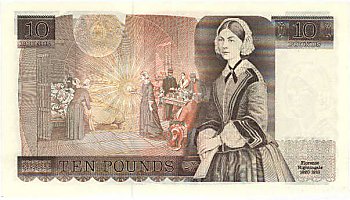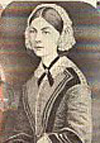Florence Nightingale
Famous for her contributions to nursing science, it is less well known that NIghingale's earliest training was in mathematics. Indeed, she studied under some of the most important mathematicians of her day, including Cayley and Sylvester; she was described as Sylvester's best pupil. She was further influenced by the Belgian Lambert Quetelet, who applied statistics to social problems.
Partly through Quetelet and partly through her deep interest in the social problems of the day, Nightingale became interested in the hospital systems in Europe. Eventually she entered nursing training in Germany over the objection of her parents who felt nursing was an unseemly occupation for a person of good social standing.
During the Crimean War the British troops were victorious on the battlefield but suffered severe casualties due to infectious diseases; public pressure on the government forced an investigation. The Secretary of War was a personal friend of Nighingale's and was familiar with both her interest in mathematics and in nursing. He offered her the title of "Superintendent of the Female Nursing Establishment of the English General Hospitals in Turkey." Thus began Nightingale's long association with public health, statistical analysis and public policy.
Driven by her passions for public service, nursing and mathematics, Nightingale gathered enormous volumes of data on health conditions in military hospitals. Her analysis of causes of mortality in the Crimean War was the first recorded use of pie charts. Later her analysis of mortality among veterans showed that returning war veterans had significantly lower life expectancies than men of similar age who were not veterans. She used this kind of analysis to argue successfully for reform sanitary conditions in military hospitals.
In recognition of her contributions to statistics and public health, Nightingale was named an honorary member of the American Statistical Society in 1883. Her image was on the UK £10 note from issued from 1975-1992.

Born: 12 May 1820 in Florence, Italy
Died: 13 August 1910 in East Wellow, England
The premiere site for biographies of mathematicians on the web is at The University of Saint Andrews in Scotland; this is the primary source of the information in these short biographies. Some biographies used additional web resources as noted in the biography.
The postage stamp images came from a wonderful site on mathematicians on stamps maintained by Jeff Miller, a mathematics teacher in Florida.
The Free Internet Encyclopedia Wikipedia is also an excellent source of information and was used as a reference for many bographies.
The opinions expressed in these biographies are those of the author and do not reflect official views of the University of Oklahoma.
